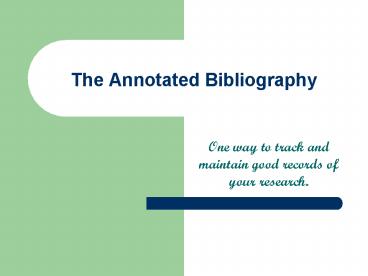The Annotated Bibliography - PowerPoint PPT Presentation
1 / 15
Title:
The Annotated Bibliography
Description:
A Bibliography is a list of citations put together on a topic of interest. ... Woodford, F. Peter, 'Sounder Thinking through Clearer Writing. ... – PowerPoint PPT presentation
Number of Views:38
Avg rating:3.0/5.0
Title: The Annotated Bibliography
1
The Annotated Bibliography
- One way to track and maintain good records of
your research.
2
What is a Bibliography?What is an Annotation?
- A Bibliography is a list of citations put
together on a topic of interest. The MLA format
is required by FHSU. - An Annotation is a remark a reader makes after
critically reading an information source. It
should include a summary of the reading, the
readers response to the reading, and questions
or comments addressing the articles clarity,
purpose, or effectiveness.
3
What is an Annotated Bibliography?
- An Annotated Bibliography is a list of
bibliographic citations that includes a
descriptive and evaluative paragraph of each
citation. - Its overall purpose is to support your study of a
subject by providing a collection of article
summaries that will reverse the need for
rereading of an article.
4
Where do I start?
- Begin by critically reading the article. View the
reading as a process in which your reading of the
authors words is influenced by your own
knowledge and experiences. - Critical readers attempt to understand the text
by asking tough questions on the articles
purpose, audience, language and content.
5
Questions to ask about an article
- Who is the author? His/her credentials?, biases?
- Where is the article published? What type of
journal is it? Who is the audience? - What do I know about the topic? Am I open to new
ideas? - Why was the article written? What is its purpose?
- What is the authors thesis? The major supporting
points or assertions?
6
Questions to ask about an article
- Did the author support his/her thesis/assertions?
- Did the article achieve its purpose?
- Was the article organized?
- Were the supporting sources credible/ believable?
- Did the article change my viewpoint on the topic?
- Was the article convincing? What new information
or ideas do I accept or reject?
7
Writing the Annotation
- A strong annotation contains
- A summary of the article
- Your response to the article
- A list of interesting or meaningful quotes
- Questions connecting the article and your
knowledge and experience.
8
The Summary Paragraph
- Begin by clearly stating the articles thesis and
major points. - Describe/define key points and how they are
connected or substantiated. - Describe the usefulness and the limitations of
the article - Limit in length to 3-4 grammatically correct
sentences
9
The Response Paragraph
- Describe your reaction to the article as a whole.
- Describe the relevance, accuracy, and quality of
the citation and its conclusions. - Document your response to the authors ideas,
argument, writing style or any other notable
aspect of the article.
10
Quotes
- Directly cite or paraphrase interesting or
meaningful quotes from the article you wish to
remember. - The usefulness of the quote should be evident
from its content. - Be sure to note the page number of the quote or
paraphrase for later referencing.
11
Questions
- Consider the articles clarity, purpose, or
effectiveness. - What do you question about the thesis or main
points? Or the argument supporting them? - What connections are there between your knowledge
experience, and the articles information? - Avoid yes/no questions they limit thought
dialogue.
12
Creating the Annotated Bib
- Start with the citation written in MLA style
- Example
- Holland, Suzanne. The Human Embryonic Stem Cell
Debate Science, Ethics, and Public Policy.
Boston MIT Press, 2001. - Pay attention to the details of a citation
- Capitalization
- Punctuation
- Use of underline
- Hanging indent
13
The Annotation
- Summarize each articles central thesis and
respond critically to the major points supporting
the thesis. - Quotes generally 3-4 quotes/article. Include
page numbers with the quote. - Questions generally 2-3 questions. You are not
expected to answer them just raise them.
14
Use the Annotation
- Attach a copy of your annotation to the article
you are annotating. Add comments as you reflect
on its content. Start an alphabetical file of
your annotated articles. - Turn in the annotation as required. Be sure to
add a title page with the submission.
15
An example of an Annotation
- Woodford, F. Peter, "Sounder Thinking through
Clearer Writing." Readings in the Arts and
Sciences. Ed. Maimon, Elaine, et al Boston
Little, Brown, and Co, 1984. 321 329. - Peter Woodford's article is reprinted in one of
the first books dedicated toward teaching
undergraduates to write in various disciplines.
This article is a critique of the tendency of
professional scientists to write in an inflated
prose style which, thorough examples drawn from
his teaching, he maintains leads to
misunderstanding on the part of the reader. He
calls for more attention to be paid to writing at
all stages of the research process and paid to
the ways in which graduate students are receive
their indoctrination into the writing conventions
of their discipline.































